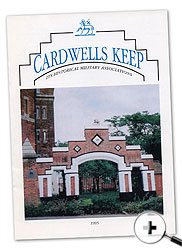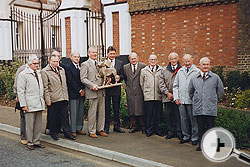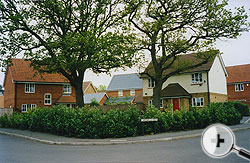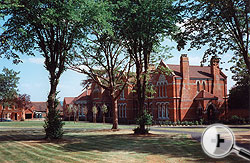 1876-1991 Stoughton Barracks
1876-1991 Stoughton Barracks
1995 Cardwells Keep
Stoughton Barracks, Guildford
In 1851, the Government offered 100,000 to Guildford Corporation for building a barracks for 20,000 soldiers on the Hog's Back. The offer was declined, but in 1873 Edward Cardwell, Secretary of State for War, chose Guildford as the site for the 2nd Regimental District (Infantry) to be known as Stoughton Barracks. Barracks were being built in county towns in order to link regiments to districts, and The Queen's (Second) Royal Regiment, was allotted Stoughton Barracks as the Regimental Depot.
 |
| The Queen's (Royal West Surrey Regiment) circa 1889. |
The barracks were completed in 1876, designed to house 300 Queensmen and be the headquarters of the 2nd Surrey Militia when they were called up for training. Its first title was 'The 48th Brigade Depot', but this was abolished in 1881 when The Queen's (Second) Royal Regiment became The Queen's Royal (West Surrey) Regiment. A married quarters block was built opposite the barracks in 1879 and by 1881, 500 men, women and children were living in Stoughton Barracks. The imposing entrance and the Keep made it a local landmark. Between 1905 and 1936 various buildings and extensions to existing buildings were added to the original plan.
During the First World War, Stoughton Barracks was also an army recruiting centre. Early in 1939 wooden huts were built to provide more accommodation in anticipation of the outbreak of the Second World War, and during the war the barracks became a reception and training centre for Infantry recruits.
 |
| Cardwells Keep Booklet. |
The Depot was the home of the Regiment where the Colonel of the Regiment had his headquarters. It was the repository of Regimental History and tradition and the place where all regular recruits received their initial training before being posted to a Battalion. Many thousands of young men passed through the archway of the Keep to be trained as soldiers of the Regiment. Older members of the Regiment always enjoyed coming back to the Depot for reunions and other Regimental functions.
From 1945 to 1949 the Depot was also a Primary Training Centre (PTC) for men called up for National Service. However, as a result of the Malayan Emergency and the outbreak of the Korean War the establishment was increased to provide a full training programme for recruits.
In July 1959 the Home Counties Brigade Depot was established at Canterbury, and recruit training at the Regimental Depot ceased. Three months later The Queen's Royal Regiment amalgamated with The East Surrey Regiment to become The Queen's Royal Surrey Regiment, and it was evident the days of the old barracks were numbered. Stoughton Barracks was finally closed as an Army Barracks in 1983.
 |
| Stoughton Barracks today. |
During 1993/94 work was started to convert Stoughton Barracks into a housing estate by Countryside Properties Plc. On conclusion of the renovations the Barracks was renamed Cardwells Keep. The Company were later awarded a Gold Award for the Best Renovation category.
The Keep was converted into flats. The Officers' Mess, now known as King George's Lodge was also converted into luxury flats. The Administration block, which housed the Orderly room and offices with the Quartermasters and RSMs quarters at each end is now known as Queen Elizabeth's Mews. Peterborough Block renamed Queen Mary's Mews has been converted into flats. Tangier Block, all Married Quarters, Medical Centre, MT Sheds, Sergeants' Mess and the Accommodation Blocks built to accommodate the militia intakes in 1936-37 behind the MT and Drill sheds, have all been demolished as have the Dining Hall and NAAFI. New attractive two, three and four bedroom houses have been built in their places. The large trees which were such a lovely feature of the barracks have been preserved.
The arch over the old road into the barracks has been refurbished and above the arch can be seen a two foot high Paschal Lamb. This Lamb was manufactured in Blairgowrie, Scotland by R W Stephens and Company. The cost of this was borne by the Developers and the Association. The Association Trustees had already decided in 1985 to record the occupation of our Depots in Guildford and Kingston. The Memorial Plaque at Stoughton can be seen to the left of the original archway in what was the entrance to the Depot. A new entrance to the site has been made by opening up the wall some fifty yards from the old entrance in the direction of Emmanuel Church.
 |
Veterans inspect the new lamb |
During the re-building of the Barracks (now known as Cardwells Keep) a small exhibition was staged in a show flat (which had been the guard room and cells) of artifacts, medals and uniforms of The Queen's Royal Regiment from 1876-1959, the period the Regiment occupied Stoughton Barracks. It had been planned to allow the exhibition to be on display for nine to twelve months, but sales of flats were so good that the exhibition had to be discontinued in May. Many of our old soldiers and members of the public went to see the display whilst it was on show and several newspaper articles were published. The display was also featured on the local Southern TV.
With the full support of Guildford Borough Council and Countryside Properties the Association asked for some form of recognition to be made within the barracks of the Regiment's stay. It had been proposed to use Battle Honours but this was not acceptable. (Readers living in the Guildford area will know that several roads are already named after Queen's Battle Honours). A proposal to use the names of selected past Colonels of The Queen's was approved by the Council and the Developers, and as a result street/road names are as follows, Teviot Close, Fairborne Way, Kirkfields, Torrens Close, Monro Drive, Giffard Way and Whitfield Close. With the assistance of Major Jock Haswell who wrote the text, an illustrated short history of the Regiment and its links with Stoughton was produced. A copy of this was given to every home owner in Cardwells Keep.
This plaque records that the Depot of The Queen's Royal West Surrey Regiment raised in 1661 for service in Tangiers was under The Cardwell reforms linked to West Surrey.
Stoughton was the home of The Regiment from 1876 to 1959 where those joining were trained before leaving to serve their Sovereign and Country in Peace and War.
PRISTINAE VIRTUTIS MEMOR




With the erection of the Memorial Plaque recording the Queen's Royal Regiments occupation on the wall outside the barracks the final chapter of our history can be considered completed, and it seems fitting to complete this article with our old motto.
Pristinae Virtutis Memor
1) Readers may be interested to know that the Lamb featured on the Memorial Plaque was cast from a mould of a silver lamb presented by Colonel F D Watney TD who commanded the 1st/4th Queen's - in the First World War
Related
![]()
Zoom Images on this page
- Click to view enlarged
- Hover over image
- Click + to enlarge
- To move image,
click/hold mouse button




